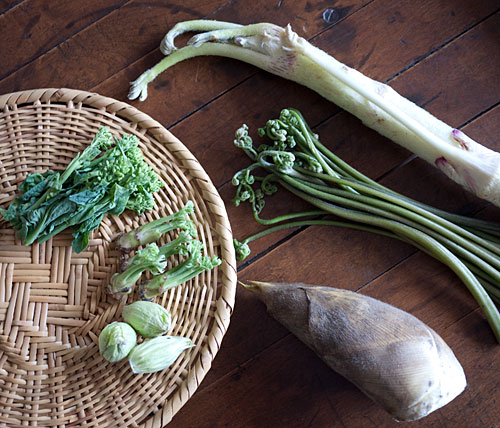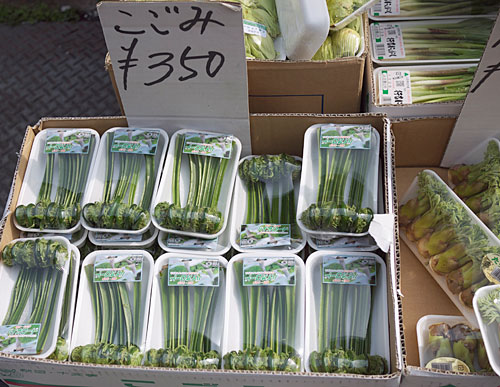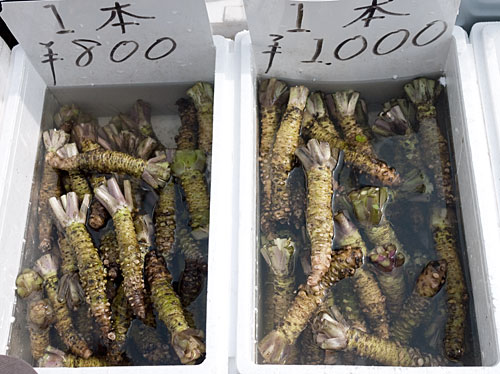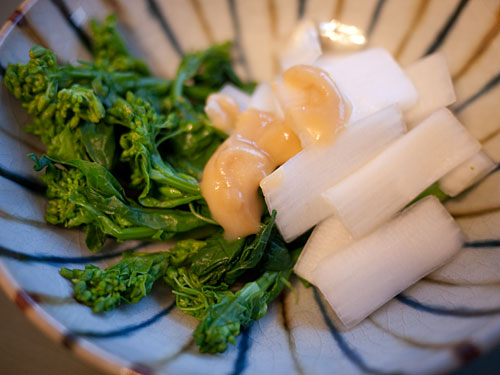Spring vegetables article in the Japan Times

I seem to have vegetables on my mind a lot these days - it is springtime after all. This month's article for the Japan Times is all about spring vegetables that are more or less unique to Japan. You may know about takenoko or bamboo shoots, but do you know fuki, and warabi, and udo? And did you know that the young leaves of the wasabi plant are a great delicacy, only available in the spring? Well...read and find out!
If you are in Japan, you can get these vegetables is to just go to your local well-stocked supermarket or department stall food hall. Unfortunately, as far as I know most of these vegetables are not available outside of Japan, unless you grow them yourself or are very lucky and find them at a Japanese grocery store or something like that. (But most readers of the Japan Times live in Japan so I can get away with writing about only-in-Japan things a bit more there ^_^;.) I don't even know if you can get the seeds for them. You can get the roots of some things, such as fuki (butterbur) or wasabi and try your luck. My mother used to grow a ton of fuki in her garden on Long Island, NY. It even became a bit invasive. So if you can get some roots, give it a go!
I have to admit that as a kid, I used to hate all of these wild vegetables, especially fuki and fuki no tou, because of their bitterness. Now I crave them. Modern hybridized vegetables seem so uniformly bland, that it's rather nice to have a zing of extra sharpness or bitterness from varieties that have not had all the bite bred out of them.
Here are some more spring vegetables sold at the Nishiki market in Kyoto and Tsukiji Jougai (outdoors) market in Tokyo these past couple of weeks. (I've written about the Nishiki Market here, but not about the Tsukiji Market. And I should, because all in all I prefer the more raucous Tokyo market. I'll get to it soon.)
So, this is from Nishiki Market. If you can read hiragana, see how many unfamiliar vegetable labels you can make out. ^_^ For instance, I have no idea how "aloe shoots" (aroe no me) are supposed to be eaten, or that they were eaten at all.

Another from the Nishiki Market. On the right are some gorgeous looking mitsuba - you should be able to get mitsuba at least at well stocked Japanese grocery stores. On the left are bunches of flowering wasabi. I've never had these but I imagine you prepare them the same way as wasabi leaves (called wasabi-na in the eastern part of Japan, ha-wasabi in the west).

This display is from the Tsukiji outdoors market. (Outdoors or jougai means it's outside of the wholesale area, where the famous fish auctions take place. Tons of little shops line the streets and are worth a trip even if you can't get into the wholesale area.) The main thing on show here is kogomi, a mountain vegetable similar to warabi. You can also see gyouja ninniku in the back right - these are sort of like bärlauch or wild garlic.

And finally, some pretty nice looking wasabi roots for sale at Tsukiji, in case you've never seen the real thing.

The Japan Time article has a recipe for tempura using some of these spring vegetables. Another way to enjoy them is to simply blanch them (some vegetables need special de-bittering treatment, which is described in the article) and serve with a dressing. Here's a little dish of blanched nanohana with the thinly sliced raw mountain udo core. Udo is a bit like parsnip; the outer part is a bit tough, and the core is tender and nice eaten raw in a salad. The sauce here is sumiso, a mixture of white miso, vinegar and a little sugar.

As I say in the Japan Times article you don't want to eat a big amount of these vegetables, but in small quantities they are really wonderful, a sure sign of spring.
The very fact that these vegetables are even eaten at all (tree shoots? Fern sprouts?) shows how resourceful people used to be - or maybe how desperate they were for food. Kind of puts those people panic-buying cup noodles from convenience stores to shame. Anyway...eating these bitter vegetables is a reminder of our past, not only in terms of our food culture, but showing us what we are capable of.
If you enjoyed this article, please consider becoming my patron via Patreon. ^_^

 Welcome to Just Hungry, where we serve authentic Japanese recipes and more! I'm
Welcome to Just Hungry, where we serve authentic Japanese recipes and more! I'm 












Comments
Louisa
22 April, 2011 - 02:34
Permalink
Re: Spring vegetables article in the Japan Times
I never knew people ate aloe either, until I saw aloe juice (with chunks) for sale at Trader Joe's. Though I haven't had the urge to try it!
pigflyin
22 April, 2011 - 03:00
Permalink
Re: Spring vegetables article in the Japan Times
Thanks for writing about these fantastic vegetables! They are one of my fav things to try to have when I travel around. My current fav would be Yama Udo. To me the fragrant of the young tree stem just magical. I think the way you do them here is much better than tempura :) more respectful.
I also found that modern cultivar vegetables are getting more & more boring and I am going back to older varieties.
Italian have something very similar to nanohana called cime di rape. Same family, and they are eaten for their bitter spring shoot and flowers too.
I am hoping that I can grow some Tara No Me at home back in Australia.... at least that's not a tree ! :)
stefafra
22 April, 2011 - 15:46
Permalink
Re: Spring vegetables article in the Japan Times
Spring vegetables, now that I moved away from Switzerland I surprise myself craving bärlauch, I used to consider it not much better than a weed in my garden in Zürich, were it was growing like, well, a weed. Then I moved to Fribourg and there it was rarer, the chalkyer soil was not ideal for it. And here in Norfolk, chalky too, it is basically impossible to find....
My father used to collect all sort of spring vegetables, my mother thought we were a bit like goats, but it was fun, and yummy.
I never tried fiddleheads, fern buds, I read that they are carcinogenic and I do fear them a bit.
kitty-chan
23 April, 2011 - 17:06
Permalink
Re: Spring vegetables article in the Japan Times
It seems every time you go to Japan you explain some thing or another that I feel I missed out on while I lived there. The fact that so many unique Japanese vegetables are listed under the general banner of "sansai" meant that much of the time when I saw them in shops, I would look with curiosity, but never try due to having no clue how to prepare them.
I think for most Americans these days, we tend to forget that there is food out there, in the wild. Most of my generation was told by our parents not to eat anything we found outside as it might be poisonous, or dangerous, or dirty, so now when we think food, we think it comes from the supermarket, not from the earth.
I didn't realize this until a friend and I were sitting in a park in northern Shinjuku and he noticed a tree with fresh loquats. When he suggested we eat them for a snack I was taken aback. When I tried it, I was amazed at how something so delicious was hanging right above our heads the whole time! Sometimes we need to remember that food really does grow on trees...
Ruth
24 April, 2011 - 05:31
Permalink
Re: Spring vegetables article in the Japan Times
Please do not avoid fiddleheads as a spring vegetable. Blanched with a change of water and once a year does not increase your chances of getting cancer any more than eating any of the more ubiquitous GMO products that are out there in the markets.
Fiddleheads are a favourite in Canada.
emmy
26 April, 2011 - 06:43
Permalink
Re: Spring vegetables article in the Japan Times
Thank you for sharing your article in the Japan Times.I was looking for information on how to prepare sansai and now I know. Thanks again!
stefafra2
26 April, 2011 - 14:15
Permalink
Re: Spring vegetables article in the Japan Times
Well, I don't want to jump on this thread, but nobody has ever found or demostrated any suspect of cancerogenicity for GMOs.
I know the field since I'm a molecular biologist working on plant pathology and we use GMOs both as tool for research and as possible way to defend cultures against pathogens.
The amount of obstacles and paperwork and regulations we have to overcome as European scientist to even field-test GMO plants, compared with almost every other place in the world, is enormous and overblown.
We don't have "GMOs in the markets" in Europe, we are "safe" but have the same cancer incidence and distribution as in "GMO contaminated" lands.
As for ferns, I did a quick literature search and found this:
http://www.benthamdirect.org/pages/content.php?CMC/2002/00000009/0000000...
Unfortunately my institution does not subscribe to this journal, but just the abstract is a bit worrying:
"Bracken poisoning has been attributed chiefly to ptaquiloside, a norsesquiterpene which is also a potent carcinogen inducing various malignancies in laboratory animals......Some human populations also eat young bracken shoots and epidemiological studies in Japan and Brazil have shown a close association between bracken consumption and cancers of the upper alimentary tract. In addition, other studies reveal that the mere presence of bracken swards represents a greater risk to die of gastric adenocarcinoma for people who live more than 20 years in such areas or are exposed in childhood. "
Ehem, may be I'll try them once in a lifetime if I ever encounter them prepared by somebody who knows how to do that, but even if they are cute and green I'll keep clear of them.
Koryu
19 May, 2011 - 18:37
Permalink
Re: Spring vegetables article in the Japan Times
I agree with your comments in regards to GMO.
An interesting article about Bracken, sadly my institution also does not support that journal...the only thing of note is possibly that not all ferns are neccessarily like Bracken. Considering the circumstances and variety of the fern family it is quite possible for edible and less toxic variants to exist and allow for people to eat them. Also it could be considered that the preparation method could change the level of toxicity as with some yams (random example I know), where leaching gets rid of the toxins to make them edible. Will need to do some reading to that regard sometime. Edible species include the ostrich fern or shuttlecock fern (Matteuccia struthiopteris)and the Vegetable fern (Diplazium esculentum).
Back to working on my basil for now though.
stefafra
26 April, 2011 - 15:50
Permalink
Re: Spring vegetables article in the Japan Times
Sorry, comment before posted as "stefafra2" since I could not figure out how to login....
Sometime I'm clumsy.
anon.
11 May, 2011 - 03:58
Permalink
Re: Spring vegetables article in the Japan Times
I went to Nishiki ichiba A LOT, and yet still managed to miss the veggie stores :-o We always beelined for the soymilk soft-serve ice-cream, the warabi-mochi & sweets store, and the fish store (I don't actually buy fish there because we live about 40 mins away on the Hankyu, but it's just so much fun seeing all kinds of fish and shellfish there). Funny though, I always thought Japan didn't have a large variety of greens because my host mom only had greens on the table twice a week or so...It's mostly tsukemono or gobo or something else. Anyway, the article on japantimes was interesting :D thanks for all the pictures of Japanese vegetables ^^ I find them sometimes now in Japanese grocery stores here in the US, but it's soooo expensive...
Der Kieler
12 May, 2011 - 21:04
Permalink
Re: Spring vegetables article in the Japan Times
Thanx a lot for this interesting article and the useful tips ..!
Claudine
14 May, 2011 - 18:33
Permalink
Re: Spring vegetables article in the Japan Times
Thanks for this - we were recently in Japan and I so enjoyed sampling the springtime veggies. We especially loved the fuki and warabi, and on occasion, wasabi stems and flowers.
Peg
5 March, 2013 - 11:12
Permalink
Re: Spring vegetables article in the Japan Times
Is there an English name for tsubamina? I've seen this vegetable only the past few years and have been using it in soups. How is it traditionally served?
maki
6 March, 2013 - 00:06
Permalink
Re: Spring vegetables article in the Japan Times
The term 'tsumamina' is sort of like mesclun, or 'cut and come again baby salad leaves'. It just means 'plucked leaves'. Usually it's the young leaves of daikon radish or turnips, or seed that's specifically sown to be used as tsumamina that's related to one or the other. They are a bit peppery, like cress.